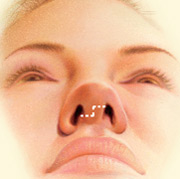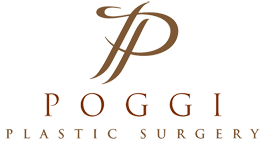.jpg)
Rhinoplasty or nose surgery, sometimes referred to as “nose reshaping” or a “nose job,” improves the appearance and proportion of your nose, enhancing facial harmony and self confidence. Surgery of the nose may also correct impaired breathing caused by structural abnormalities in the nose.
Enhancing your appearance with nose plastic surgery
While the shape of your nose is usually the result of heredity, the appearance may have been altered in an injury or during prior surgery.
What can surgery of the nose accomplish?
Rhinoplasty surgery can change:
- Nose size, in relation to the other facial structures
- Nose width, at the bridge
- Nose profile, with visible humps or depressions on the bridge
- Nasal tip, that is large or bulbous, drooping, or too upturned
- Nostrils that are large, wide or upturned
- Nasal asymmetry and deviation
Is it right for me?
Nose cosmetic surgery is a highly individualized procedure and you should do it for yourself, not to fulfill someone else’s desires or to try to fit any sort of ideal image.
A rhinoplasty procedure is a good option for you if:
- Your facial growth is complete and you are 13 years of age or older
- You are physically healthy
- You do not smoke
- You have specific, but realistic goals in mind for the improvement of your appearance
Rhinoplasty at a glance
Nose reshaping was one of the top five surgical cosmetic procedures performed in 2009. 256,000 people had nose surgery in 2009.
| Age | |
| 13-19 | 14% |
| 20-39 | 30% |
| 40-55+ | 22% |
| Gender | |
| Males | 26% |
| Females | 74% |
The success and safety of your nose surgery depends very much on your complete candidness during your consultation. You’ll be asked a number of questions about your health, desires and lifestyle before rhinoplasty surgery.
.jpg) Be prepared to discuss:
Be prepared to discuss:
- Why you want the surgery, your expectations and desired outcome
- Medical conditions, drug allergies and previous medical treatments
- Use of current medications, vitamins, herbal supplements, alcohol, tobacco and drugs
- Previous surgeries
Your surgeon may also:
- Evaluate your general health status and any pre-existing health conditions or risk factors
- Examine and measure your face
- Take photographs for your medical record
- Discuss your options and recommend a course of reshaping your nose
- Discuss likely outcomes of a nose surgery and any risks or potential complications
- Discuss the type of anesthesia that will be used
Before nose surgery, you may be asked to:
- Get lab testing or a medical evaluation
- Take certain medications or adjust your current medications
- Stop smoking well in advance of surgery
- Avoid taking aspirin, anti-inflammatory drugs and herbal supplements as they can increase bleeding
Special instructions you receive will cover:
- What to do on the night before and the morning of surgery
- The use of anesthesia during your nose surgery
- Post-operative care and follow-up
Your plastic surgeon will also discuss where your procedure will be performed. Surgery of the nose may be performed in an accredited office-based surgical center, outpatient or ambulatory surgical center, or a hospital.
You’ll need help
If your nose surgery is performed on an outpatient basis, be sure to arrange for someone to drive you to and from surgery and to stay with you for at least the first night following surgery.
Step 1 – Anesthesia
Medications are administered for your comfort during rhinoplasty surgery. The choices include intravenous sedation or general anesthesia. Your doctor will recommend the best choice for you.
Step 2 – The incision
Surgery of the nose is performed either using a closed procedure, where incisions are hidden inside the nose, or an open procedure, where an incision is made across the columella, the narrow strip of tissue that separates the nostrils.
Through these incisions, the soft tissues that cover the nose are gently raised, allowing access to reshape the structure of the nose.
.jpg)
.jpg)
Step 3 – Reshaping the nose structure
Surgery of the nose can reduce or augment nasal structures with the use of cartilage grafted from other areas of your body.
Most commonly, pieces of cartilage from the septum, the partition in the middle of the nose, is used for this purpose.
Occasionally a piece of cartilage from the ear and rarely a section of rib cartilage can be used.
Step 4 – Correcting a deviated septum
If the septum is deviated, it is now straightened and the projections inside the nose are reduced to improve breathing.
Step 5 – Closing the incision
Once the underlying structure of the nose is sculpted to the desired shape, nasal skin and tissue is redraped and incisions are closed. Additional incisions may be placed in the natural creases of the nostrils to alter their size.
Step 6 – See the results
Splints and internal tubes will likely support the nose as it begins to heal for approximately one week.
While initial swelling subsides within a few weeks, it may take up to a year for your new nasal contour to fully refine.
During this time you may notice gradual changes in the appearance of your nose as it refines to a more permanent outcome. Swelling may come and go and worsen in the morning during the first year following your nose surgery.


A nose surgery procedure to improve an obstructed airway requires careful evaluation of the nasal structure as it relates to airflow and breathing. Correction of a deviated septum, one of the most common causes of breathing impairment, is achieved by adjusting the nasal structure to produce better alignment.
 The decision to have nose surgery is extremely personal and you’ll have to decide if the benefits will fulfill your goals and if the risks and potential rhinoplasty complications are acceptable.
The decision to have nose surgery is extremely personal and you’ll have to decide if the benefits will fulfill your goals and if the risks and potential rhinoplasty complications are acceptable.
Your plastic surgeon and/or staff will explain in detail the risks associated with surgery. You will be asked to sign consent forms to ensure that you fully understand the procedure you will undergo and any risks or potential complications.
The risks of rhinoplasty include:
- Rupture of small surface vessels of the nose
- Infection
- Poor wound healing
- Anesthesia risks
- Bleeding (hematoma)
- Nose asymmetry
- Cardiac and pulmonary complications can occur in longer surgical procedures and may be associated with the formation of, or increase in, blood clots in the venous system
- Change in skin sensation (numbness)
- Nasal airway alterations may occur after a rhinoplasty or septoplasty that may interfere with normal passage of air through the nose
- Nasal septal perforation (a hole in the nasal septum) may develop but is rare; additional surgical treatment may be necessary to repair the nasal septum but in some cases, it may be impossible to correct this complication
- Pain, which may persist
- Unfavorable rhinoplasty scarring
- Skin contour irregularities
- Skin discoloration and post rhinoplasty swelling
- Sutures may spontaneously surface through the skin, become visible or produce irritation that require removal
- Possibility of revisional surgery
Be sure to ask questions:
It’s very important to ask your plastic surgeon questions about your nose procedure. It’s natural to feel some anxiety, whether it’s excitement for your anticipated new look or a bit of preoperative stress. Don’t be shy about discussing these feelings with your plastic surgeon.
When you go home
If you experience shortness of breath, chest pains, or unusual heart beats, seek medical attention immediately. Should any of these complications occur, you may require hospitalization and additional treatment.
The practice of medicine and surgery is not an exact science. Although good results are expected, there is no guarantee. In some situations, it may not be possible to achieve optimal results with a single surgical procedure. Another minor surgery may be necessary to reach the intended aesthetic goal.
Be careful
Following your physician’s instructions is key to the success of your surgery. It is important that the surgical incisions are not subjected to excessive force, abrasion, or motion during your recovery from rhinoplasty. Your doctor will give you specific instructions on how to care for yourself.
.jpg) After your procedure is completed, a splint, internal tubes or packing will likely be placed inside your nose and a splint or bandages placed on the outside to support and protect the new structures during initial healing.
After your procedure is completed, a splint, internal tubes or packing will likely be placed inside your nose and a splint or bandages placed on the outside to support and protect the new structures during initial healing.
You will be given specific instructions to follow during your recovery from rhinoplasty: How to care for the surgical site, medications to apply or take orally to aid healing and reduce the potential for infection, specific concerns to look for at the surgical site or in your general health, and when to follow up with your plastic surgeon.
Be sure to ask your plastic surgeon specific questions about what you can expect during your individual recovery period.
- Where will I be taken after my surgery is complete?
- What medication will I be given or prescribed after surgery?
- Will I have dressings/bandages after surgery?
When will they be removed? - Are stitches removed? When?
- When can I resume normal activity and exercise?
- When do I return for follow-up care?
- How long will swelling after rhinoplasty surgery persist?
.jpg) It may take several months for swelling to fully dissipate and up to a year – and sometimes longer – for the outcome of the surgery to fully refine after rhinoplasty surgery.
It may take several months for swelling to fully dissipate and up to a year – and sometimes longer – for the outcome of the surgery to fully refine after rhinoplasty surgery.
Although the results of nose surgery are usually permanent, cartilage may continue to reshape and move tissue that may change the outcome over time.
Cost is always a consideration in elective surgery. Rhinoplasty prices can vary widely. A surgeon’s cost may vary based on his or her experience as well as geographic office location.
Many plastic surgeons offer patient financing plans, so be sure to ask.
The price of nose surgery may include:
- Surgeon’s fee
- Hospital or surgical facility costs
- Anesthesia fees
- Prescriptions for medication
- Medical tests
When nose surgery is performed to improve breathing function, this procedure is considered reconstructive and may be covered by insurance. This requires a detailed examination to verify the cause of your breathing impairment and prior authorization from your insurer.
.jpg) Your satisfaction involves more than a fee.
Your satisfaction involves more than a fee.
When choosing a plastic surgeon for nose surgery, remember that the surgeon’s experience and your comfort with him or her are just as important as the final cost of the surgery.
- Cartilage: Connective tissue that forms the structure of the nose.
- Columella: The narrow strip of tissue that separates the nostrils.
- Deviated septum: Cartilage that separates the nostrils is misaligned which may cause partial nasal airway obstruction.
- General anesthesia: Drugs and/or gases used during an operation to relieve pain and alter consciousness.
- Hematoma: Blood pooling beneath the skin.
- Intravenous sedation: Sedatives administered by injection into a vein to help you relax.
- Local anesthesia: A drug injected directly to the site of an incision during an operation to relieve pain.
- Rhinoplasty: Surgery to reshape the nose.
Use this checklist as a guide during your nose surgery consultation.
- Are you certified by the American Board of Plastic Surgery?
- Are you a member of the American Society of Plastic Surgeons?
- Were you specifically trained in the field of plastic surgery?
- How many years of plastic surgery training have you had?
- Do you have hospital privileges to perform this procedure? If so, at which hospitals?
- Is the office-based surgical facility accredited by a nationally- or state-recognized accrediting agency, or is it state-licensed or Medicare-certified?
- Am I a good candidate for this procedure?
- What will be expected of me to get the best results?
- Where and how will you perform my procedure?
- What surgical technique is recommended for me?
- How long of a recovery period can I expect, and what kind of help will I need during my recovery?
- What are the risks and complications associated with my procedure?
- How are complications handled?
- How can I expect my nose to look over time?
- What are my options if I am dissatisfied with the cosmetic outcome of my nose surgery?
- Do you have before-and-after photos I can look at for this procedure and what results are reasonable for me?
Plastic surgery involves many choices. The first and most important is selecting a surgeon you can trust.
Choosing an ASPS Member Surgeon ensures that you have selected a physician who:
- Has completed at least five years of surgical training with a minimum of two years in plastic surgery.
- Is trained and experienced in all plastic surgery procedures, including breast, body, face and reconstruction.
- Operates only in accredited medical facilities.
- Adheres to a strict code of ethics.
- Fulfills continuing medical education requirements, including standards and innovations in patient safety.
- Is board certified by The American Board of Plastic Surgery or in Canada by the Royal College of Physicians and Surgeons of Canada®.
ASPS Member Surgeons are your partners in cosmetic and reconstructive plastic surgery.
Look for the ASPS Member Surgeon logo.

 3510 N. Ridge Rd, Suite 100
3510 N. Ridge Rd, Suite 100